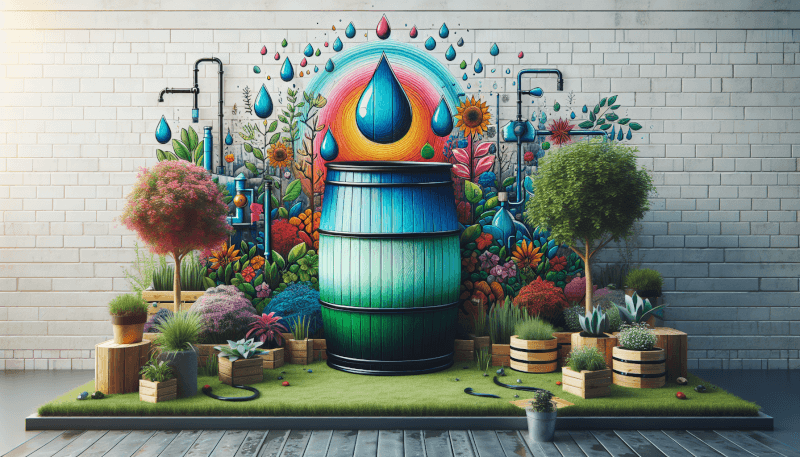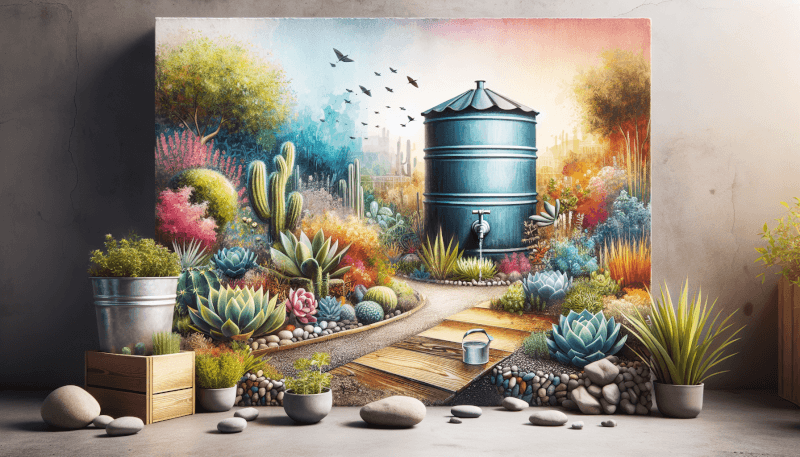In this article, you will discover the best ways to design your own water-wise garden. With increasing concerns about water scarcity and the need for sustainable gardening practices, creating a garden that conserves water is not only environmentally friendly but also cost-effective. By implementing these design strategies, you can create a beautiful and vibrant garden that thrives with minimal water usage. Whether you are a seasoned gardener or a beginner, these tips and tricks will guide you in creating a DIY water-wise garden that will make your neighbors green with envy. So, grab your gardening gloves and let’s get started on this exciting journey towards a greener and more sustainable garden.
Choosing the Right Plants
When it comes to designing a water-wise garden, selecting the right plants is crucial. By choosing plants that are native to your region, you can ensure they are well-suited to the local climate and soil conditions. Native plants have adapted to the environment over time and are naturally more resistant to pests and diseases. They also require less water since they are already accustomed to the local rainfall patterns.
In addition to native plants, opting for drought-tolerant varieties is another smart choice for a water-wise garden. These plants have evolved to survive in low-water conditions and can thrive with minimal irrigation. Drought-tolerant plants come in various shapes, sizes, and colors, allowing you to create a visually appealing garden that conserves water at the same time.
When selecting plants, it’s important to consider their water needs. Some plants require more water than others, so it’s essential to group them accordingly. By grouping plants with similar water needs together, you can ensure efficient irrigation and prevent water waste.
Assessing Soil and Drainage
To create a thriving water-wise garden, it’s crucial to assess your soil and address any drainage issues. Conducting a soil test can provide valuable insights into the soil’s composition, pH levels, and nutrient content. This information will help you determine what amendments, if any, are needed to improve the soil quality.
Improving soil structure and drainage is another key step in designing a water-wise garden. Amending the soil with organic matter, such as compost or aged manure, can improve its ability to retain moisture and allow for better drainage. Creating raised planting beds with well-draining soil can also help prevent waterlogging and ensure the roots have access to oxygen.
For added water conservation, consider using mulch in your planting beds. Mulch helps regulate soil temperature, reduces evaporation, and suppresses weed growth. Apply a layer of organic mulch, such as wood chips or straw, around your plants to help conserve moisture in the soil.

Efficient Irrigation Techniques
One of the most effective ways to conserve water in your garden is by implementing efficient irrigation techniques. Installing a drip irrigation system is a great option since it delivers water directly to the plant roots, minimizing wastage through evaporation or runoff. Drip irrigation systems can be customized to match the water needs of different plants, ensuring each receives just the right amount of water.
Another water-wise irrigation method is using soaker hoses. These hoses release water slowly and directly into the soil, allowing it to be absorbed by the roots without any significant loss due to evaporation. Soaker hoses are especially useful for watering larger areas or rows of plants.
Practicing water-efficient watering methods is also important. Water your garden during the early morning or late evening when temperatures are cooler, as this reduces water loss through evaporation. It’s also advisable to water deeply and infrequently, encouraging plant roots to grow deeper into the soil to access moisture.
Implementing Rainwater Harvesting
Rainwater harvesting is an excellent way to conserve water and reduce reliance on municipal water sources. There are several methods you can incorporate into your water-wise garden to make the most of rainwater.
Installing rain barrels is a simple and effective way to collect rainwater. Place the barrels strategically beneath downspouts to capture runoff from your roof. The collected rainwater can then be used to irrigate your garden during dry periods. It’s important to cover the barrels to prevent mosquitoes from breeding and to keep the water clean.
Designing a rain garden is another popular rainwater harvesting technique. A rain garden is a landscaped area designed to capture and absorb rainwater from impermeable surfaces, such as roofs or driveways. By choosing plants that tolerate both wet and dry conditions, you can create a beautiful garden that also helps reduce erosion and replenish groundwater.
Utilizing permeable surfaces, such as gravel or permeable pavers, can also help capture rainwater and allow it to seep into the ground rather than running off into storm drains. This reduces water runoff and helps recharge the aquifer.

Utilizing Mulch
Mulching is a simple yet effective technique for conserving moisture and suppressing weed growth in your water-wise garden. Choosing the right type of mulch is important to ensure optimal water conservation.
Organic mulches, such as wood chips, straw, or compost, are excellent choices. These materials not only help retain soil moisture by reducing evaporation but also gradually break down, enriching the soil with organic matter. In contrast, inorganic mulches, like gravel or stone, can reflect heat and increase soil temperatures, resulting in higher water evaporation rates.
When applying mulch, make sure to leave a gap around the plant stems to prevent moisture accumulation and potential rot. Apply a layer of mulch that is at least two to three inches thick to ensure adequate coverage and weed suppression.
Designing with Water Zones
Designing your garden with water zones is an effective way to efficiently irrigate your plants based on their water needs. Grouping plants with similar water requirements together allows you to customize irrigation schedules and prevent over or under-watering.
In addition to grouping plants, creating microclimates within your garden can further enhance water efficiency. Microclimates are areas within your garden that have slightly different environmental conditions, such as more or less shade, shelter from wind, or water availability. By strategically placing plants in these microclimates, you can maximize their chances of survival and reduce the need for additional irrigation.
Zoning different areas of your garden based on their irrigation needs is another smart approach. By categorizing your garden into high, moderate, and low-water zones, you can allocate resources and adjust watering schedules accordingly. This ensures that water is used efficiently and not wasted on areas that require less irrigation.

Implementing Efficient Planting Techniques
Efficient planting techniques play a vital role in water-wise gardening. Preparing the soil properly before planting is key to ensuring healthy root development and optimal water absorption. Loosening the soil with a garden fork or tiller and incorporating organic matter helps improve water infiltration and retention.
Spacing plants appropriately is another crucial factor in efficient planting. Overcrowded plants can compete for water and nutrients, leading to stunted growth and increased water demands. Be sure to follow planting recommendations for individual species and provide sufficient space for each plant to thrive.
Planting in water-saving arrangements, such as grouping plants with similar water needs together or utilizing the strategic placement of taller plants to provide shade and reduce water evaporation from the surrounding soil, can also maximize water efficiency in your garden.
Promoting Healthy Soil
Maintaining healthy soil is essential for a thriving water-wise garden. Adding organic matter, such as compost or aged manure, can improve soil fertility and structure while enhancing its water-holding capacity. Organic matter acts as a sponge, absorbing and releasing water as needed by the plants. It also improves soil aeration and nutrient availability, supporting healthy root growth.
Avoiding chemical fertilizers is also important in promoting healthy soil. These synthetic fertilizers can cause water pollution and disrupt the natural balance of soil microorganisms. Instead, opt for organic fertilizers or incorporate natural soil amendments, like bone meal or kelp meal, to provide long-term nutrient availability to your plants.
Maintaining soil moisture levels is crucial for both plant health and water conservation. Regularly monitor soil moisture and water your garden when necessary. Mulching, as mentioned earlier, can greatly help in retaining moisture and reducing water loss through evaporation.

Implementing Smart Lawn Care Practices
Lawns traditionally require a significant amount of water to stay green and lush. However, there are several smart lawn care practices you can implement to make your lawn more water-wise.
Reducing the size of the lawn is one effective strategy. Consider replacing areas of the lawn with drought-resistant ground covers, native plants, or hardscaping features. This not only reduces water demand but also adds visual interest and diversity to your landscape.
Choosing drought-resistant grass species is another important aspect of water-wise lawn care. There are several varieties available that are specifically bred to withstand dry conditions and require less irrigation. These grasses have deep root systems, enabling them to access water deeper in the soil and stay green even during drought periods.
Practicing proper mowing and watering techniques is also vital for a healthy water-wise lawn. Set your mower blades to a higher cutting height to promote root growth and shade the soil, reducing water evaporation. When watering your lawn, apply water deeply and infrequently to encourage deep root growth and avoid shallow, drought-prone roots.
Creating a Wildlife-Friendly Habitat
Designing a water-wise garden doesn’t mean sacrificing biodiversity or wildlife habitats. In fact, you can create a beautiful garden that also attracts and supports a variety of beneficial wildlife.
Incorporating bird feeders and houses is a great way to attract birds to your garden. Birds not only add beauty and music to your outdoor space but also help control pests by feeding on insects.
Providing water sources for wildlife is essential, especially during dry periods. Birdbaths, shallow ponds, or even a simple water dish can serve as a reliable water source for birds, bees, and other beneficial insects. Just make sure to clean and refill the water regularly to prevent mosquito breeding.
Planting for butterfly and bee populations is also crucial for a wildlife-friendly habitat. These pollinators play a vital role in plant reproduction and ecosystem health. Choose nectar-rich flowers and plants that provide food and shelter for butterflies and bees. Native flowering plants are particularly effective in attracting and supporting these important pollinators.
By following these best practices and incorporating water-wise design strategies, you can create a stunning and sustainable garden that conserves water, promotes healthy ecosystems, and adds beauty to your outdoor space. So go ahead and embark on your DIY water-wise garden journey — you and the environment will both benefit from your efforts!



